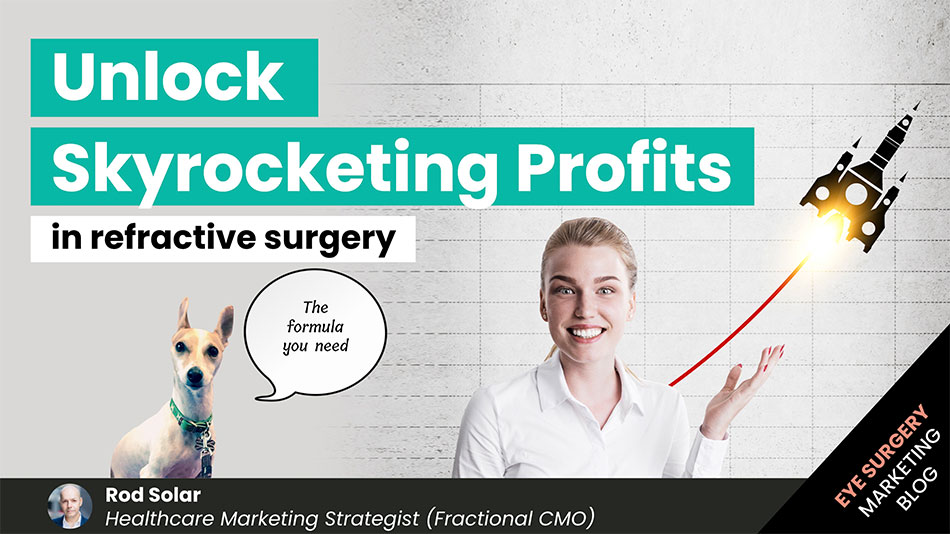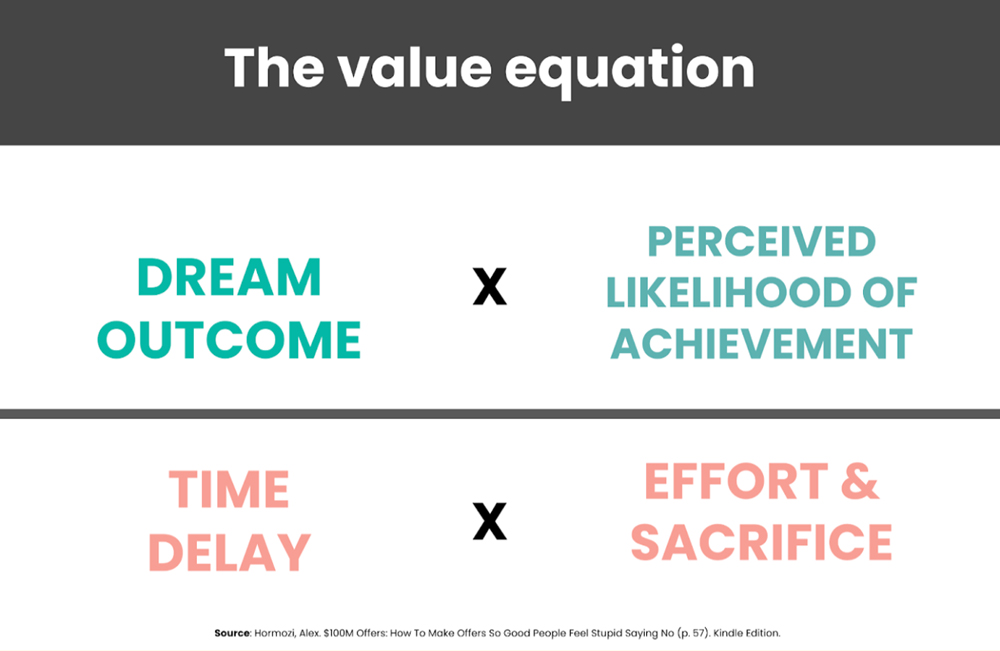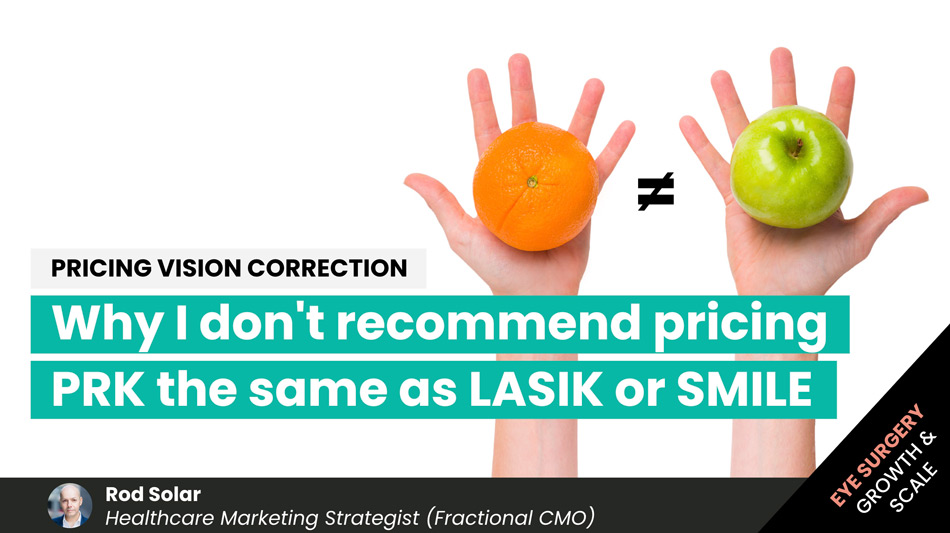
Unlock skyrocketing profits in refractive surgery by using this transformational formula
Discover the secret to exponential business growth in refractive surgery: delivering unparalleled value to your patients. In today's competitive landscape, offering quality healthcare services is no longer enough. Transform your practice into a profit powerhouse by elevating patient experiences and creating the value they simply can't resist. Dive into this must-read guide to learn the winning strategies and insights to set your practice apart, attract loyal patients, and propel your bottom line to new heights.
Unleash your profit potential by getting well past the break-even point
Refractive surgery, a predominantly fixed-cost business, presents unique challenges for newcomers seeking to break into the market.
With patient treatment costs remaining relatively stable, aspiring competitors must surpass a critical patient threshold before reaping the rewards of their investments.
Once this breakeven point is achieved, each additional patient contributes substantially to the bottom line due to the minimal costs of providing care. To truly maximise profits in this industry, it's essential to not only raise your prices but also deliver unparalleled value that justifies your position as the most valuable offer in the market.
Don't just be a provider; become the gold standard in refractive surgery that patients cannot resist.
Why you still underprice your services
Many practice owners are hesitant to raise their prices due to various fears and concerns. Some of the most common fears include:
- Losing patients: The fear of losing customers to competitors with lower prices is a significant concern for many practice owners. They worry that increasing prices may drive away price-sensitive customers, reducing sales volume.
- Damaging brand reputation: Practice owners may worry that raising prices could tarnish their brand's image and erode customer trust, mainly if the increase is unjustified or excessive.
- Stagnating growth: Some practice owners fear that higher prices might slow their growth, as new customers may hesitate to try their products or services at a premium price.
- Price wars: Practice owners might be concerned about triggering a price war with competitors, leading to an ongoing cycle of price cuts that can damage all parties involved.
- Market conditions: In uncertain economic times, practice owners may worry that raising prices could be viewed negatively by customers who are already struggling financially.
- Implementation challenges: Some practice owners may fear the logistical challenges of implementing price increases, such as updating pricing structures, informing customers, and training staff to handle potential objections.
To overcome these fears, business owners must carefully consider the value they are providing to their customers and develop a strategic plan to justify and communicate any price increases effectively.
The formula for how customers perceive value
The value equation is a concept that helps you understand how to create and enhance the perceived value of a product or service in customers' eyes. It consists of four main components, two that increase value and two that decrease value.

What do these factors mean:
Dream Outcome is the customer's desired result or benefit. The more meaningful and attractive the outcome, the higher the perceived value of your product or service.
Perceived Likelihood of Achievement: This refers to the customer's belief in their ability to achieve the desired outcome using your product or service. The higher the likelihood of success, the more valuable your offering will appear.
Time Delay: This is the time it takes for the customer to experience the desired outcome after purchasing your product or service. The shorter the time delay, the more valuable your offering will appear.
Effort and Sacrifice: This refers to the work, inconvenience, or discomfort the customer must endure to achieve the desired outcome. The less effort and sacrifice required, your offering will appear valuable.
To create maximum value for your customers, you should aim to enhance the dream outcome and perceived likelihood of achievement while reducing the time delay, effort, and sacrifice involved. This will make your product or service more appealing and valuable in the eyes of your target audience.
Applying the value equation to refractive surgery
In this guide, we will apply Alex Hormozi's value equation to the context of a refractive surgery practice owner wanting to increase their price by adding more value to their offering. We will summarise the recommendations and provide examples of applying these concepts to your practice.
Dream Outcome - How to Enhance the Desirability of Your Surgery
As a refractive surgeon, you have one of the best dream outcomes available on the market - clear vision without glasses and contact lenses. Yet, many refractive surgeons don’t focus on that dream outcome in their advertising and messaging. Instead, they spend time and energy explaining how they deliver the dream outcome.
I often point to how holiday promoters market their holidays. Do you see them explaining how planes work (technology), how to get through security (suitability) and what can go wrong (risks)? Or do they focus on happy people enjoying their incredible holiday of a lifetime (dream outcome)?
If you want to keep your prospect focused on the desirability of your service - identify their dream outcome and then focus everything on that.
Perceived Likelihood - Boost Confidence in Your Practice's Results
If you wanted to increase the likelihood of getting a successful outcome from any service, would you go to the person who’s delivered the product 10,000 times, or would you go to the person who’s done it once?
The answer is obvious. Even if the person who’s done it once spends 10X as long with you as the person who’s done it 10,000 times, you’ll pay more for the person who is most likely to deliver the dream outcome because there is value in certainty.
To increase the perceived likelihood of the patient achieving the dream outcome, showcase your practice's success stories and testimonials from satisfied patients.
Highlight your surgeons' qualifications, experience, and the number of successful surgeries they have performed to increase patients' confidence in your practice.
Offer free consultations to assess patients' eligibility for refractive surgery, increasing their confidence in your services.
Use state-of-the-art technology and equipment to minimise surgical risks and complications, further reducing the perceived risk by patients.
Publish your outcomes and complication rates in graphical form. Make it easy for analytical patients to see what kind of results they can expect by reviewing the data you freely share on your website.
Guarantee free enhancements and unlimited post-ops. Considering how few patients will need them, every patient will benefit from that added reassurance these offers provide.
Time Delay - Minimize Time to Achieve Results
The longer your patient gets their dream outcome, the less valuable your service becomes.
Thus, massive value arises when you reduce time delay.
For example…
Streamline your appointment scheduling and surgery booking process to minimise patient waiting times. I often recommend having at least three appointment slots available within seven days at all times.
Streamline the consultation process: Optimise the patient consultation process to reduce waiting times by using online questionnaires (i.e. self-tests), phone consultations, or virtual meetings to gather preliminary information before the in-person appointment.
Improve scheduling: Implement an efficient system to minimise patient wait times, maximise clinic utilisation, and reduce appointment backlogs. Offer flexible appointment times, including evenings and weekends, to accommodate patients with busy schedules.
Enhance patient education: Provide patients with comprehensive educational materials, such as brochures, videos, and webinars, to help them understand the procedure, pre-operative preparations, and post-operative care. This can reduce the need for multiple consultations and help patients make informed decisions more quickly.
Make pre-operative assessments more efficient: Streamline pre-operative assessments by better coordinating with optometrists, ophthalmologists, and other specialists to perform necessary tests and evaluations promptly.
Implement advanced technology: Invest in the latest surgical equipment and technologies to expedite surgical procedures and reduce recovery times, enabling patients to enjoy the results sooner.
Increase staff efficiency: Train staff to handle patient inquiries, manage appointments, and assist with pre-and post-operative care efficiently. Cross-train employees so they can perform multiple tasks and fill in for each other when needed.
Optimise patient follow-up: Implement a systematic approach for post-operative care and follow-up, including phone calls, emails, or text messages, to ensure patients receive timely support and guidance during their recovery.
Collaborate with other providers: Establish partnerships with other healthcare providers, such as optometrists and primary care physicians, to facilitate referrals, expedite pre-operative assessments and post-operative care and streamline the overall patient experience.
NOTE: The best way to answer that nagging question about practice growth or marketing or patient volume in the back of your mind is to book a free 15-minute compatibility call. Get some options and go away with a clear idea of what’s possible.
Effort and Sacrifice - Reduce Inconvenience and Risk for Patients
To reduce the effort and sacrifice patients must undergo when getting and recovering from vision correction surgery, a practice can consider the following recommendations:
Prioritise website usability and speed: Evaluate the value of your website based on how easy it is for prospective and existing patients to find what they’re looking for. Nothing else matters as much.
Respond to leads within 5 minutes. To ensure leads don't get lost in the shuffle, a practice can implement technology that responds to leads in five minutes or less. This is especially important if prospective patients have completed an online form or self-test indicating they are ready to commit. Automated response emails and text messages make it much easier for your staff to contact leads before they lose interest or go elsewhere quickly. Also, practices should use a tracking system and follow up on leads so no one falls through the cracks. By responding promptly, practices can demonstrate their commitment to patient care even before the first appointment.
Offer online appointment booking: People don’t want to talk to salespeople, and that’s how they see your contact centre. Being able to view your availability online and book an appointment without making a call is a significant reduction in effort.
Offer a free appointment: Why would someone want to pay you to see if you can help them? Offering free appointments will take up time, but don’t get emotional about it - this is a math problem. Nine times out of ten, you will get sufficiently more conversions that will easily offset your time expense in offering free appointments.
Simplify your appointment booking process: I can’t tell you how often I see superfluous fields on appointment booking pages (why would you need a prospective patient’s physical address now?) People shouldn’t have to create or sign in with an account and spend 5 minutes filling out your form to book an appointment with you. Ask for only what you need.
Offer comprehensive pre-and post-operative instructions to patients that help prepare them for surgery and ensure a smooth recovery. However, providing lengthy, multi-page tomes on every aspect of refractive surgery can overwhelm patients, leaving them exhausted. Show your respect for their time by delivering concise written content and presenting complex ideas as graphics and illustrations as much as possible.
Offer flexible financing options or payment plans to reduce the financial burden on patients. Complete their forms so they don’t have to put in additional effort to arrange financing.
Offer online payment options to make it easy to pay before the surgery date and remove the stress surrounding the price on the day.
Personalised patient care: Offer tailored care plans based on each patient's needs, preferences, and lifestyle. This ensures patients receive personalised attention and feel more at ease.
Pre-operative guidance: Provide patients with clear and detailed instructions on pre-operative preparations, such as medication adjustments, lifestyle changes, and the potential need for a caregiver during the recovery period. Do this in easy-to-consume ways (like on-demand video) that don’t unnecessarily tax people’s cognitive and recall abilities.
Minimally invasive procedures: Invest in advanced surgical techniques and technologies that minimise surgical trauma and reduce recovery times. These options can make the procedure and recovery more comfortable for the patients.
Comfortable surgical environment: Create a relaxing, calming, and welcoming surgical environment to help ease patient anxiety and promote relaxation.
All-inclusive post-operative care packages: Offer patients comprehensive post-operative care packages, which may include pain management medications, eye drops, protective eyewear, and other essential supplies to make the recovery process more convenient and manageable. Don’t make them go out and spend more money buying their supplies. Bundle it for them and provide it as part of your higher-priced service.
Accessible support: Provide patients with easy access to support and information during the recovery process, such as a dedicated helpline, email support, or online chat so that they can address concerns and questions promptly.
Post-operative recovery aids: Provide patients with access to resources and aids that can facilitate their recovery, such as eye shields, cooling eye masks, and ergonomic pillows designed for post-surgery comfort.
Comprehensive follow-up care: Schedule regular appointments to monitor the patient's progress, address complications, and provide additional support and guidance.
Patient education and testimonials: Share educational resources and patient testimonials to help patients understand what to expect during the recovery process and alleviate concerns about the surgery's potential challenges.
Arrange (and possibly include) transport and accommodation for patients so they don’t have to worry about organising their visit.
Conclusion
Implementing these recommendations can help increase the value patients attach to your offer. Doing so will differentiate you from the competition and reduce price resistance when asking for the order. It will also create a more efficient and enjoyable patient experience, which builds trust and loyalty (i.e. ratings, reviews and referrals). Ultimately, this will increase patient satisfaction and help you grow your practice and make you considerably more profitable than you are today.
If you need assistance applying the above recommendations to your practice, reach out to book a free compatibility call, and we’ll see if there’s a fit.
About the author

Rod Solar
Founder & Scalable Business Advisor / fCMO
Rod Solar is a co-founder of LiveseySolar and a Scalable Business Advisor for its customers. Rod mentors and coaches eye surgery business CEOs/Founders and their leadership teams to triple their sales, double their profit, and achieve their “ideal exit”.
Related Posts
Meet our Co-Founders
We’re passionate about helping leaders of high-quality, growth-minded practice owners double their practice revenue

Rod Solar
Founder & Scalable Business Advisor
For over 20 years, I’ve helped ophthalmology entrepreneurs scale their private practices. I specialise in doubling revenue within three years by offering a proven framework, hands-on experience, and a team of experts who implement what works. We take the guesswork out of growth and scale, so you can focus on delivering exceptional patient care while maximising the value of your business.
LiveseySolar completely transformed the way we were approaching this… We’ve gone from having just the dream of having a practice to having a practice up and running with people making inquiries and booking for procedures… It’s extremely pleasing. We feel lucky we connected with LiveseySolar.
— Dr Matthew Russell, MBChB, FRANZCO, specialist ophthalmic surgeon and founder of VSON and OKKO

Laura Livesey
Founder & CEO
I’m the co-founder & CEO of LiveseySolar. I’ve developed powerful eye surgery marketing systems that increase patient volumes and profits for doctors, clinics, and hospitals, since 1997.
Rod and Laura know as much about marketing surgery to patients as I know about performing it. They are an expert in the field of laser eye surgery marketing. They know this industry inside out. I believe that they could help many companies in a variety of areas including marketing materials, sales training and marketing support for doctors.
— Prof. Dan Reinstein, MD MA FRSC DABO, founder of the London Vision Clinic, UK











